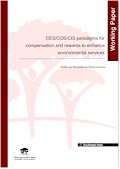| Working Paper Series |
 |
|
| Title | CES/COS/CIS paradigms for compensation and rewards to enhance environmental services | | Author | Meine van Noordwijk and Beria Leimona | | Year | 2010 | | Publisher | World Agroforestry Centre - ICRAF, SEA Regional Office | | City of Publication | Bogor, Indonesia | | Series Number | Working Paper no 100 | | Number of Pages | 30 | | Call Number | WP0129-10 | | Keywords | Asia, boundary organizations, criteria and indicators, livelihood, payment for environmental
services, RUPES |
|
| Abstract: |
| The terminology of Payments for Environmental Services (PES) has rapidly gained popularity with its focus on market-based mechanism for environmental service (ES) enhancement. Current use of the term, however, covers a broad spectrum of interactions between Essuppliers and ES-beneficiaries. A broader class of mechanisms aims at ES enhancement through compensation or rewards (CRES). Such mechanisms can be analyzed on the basis of the way they meet four principles: Realistic, Conditional, Voluntary and Pro-poor. For each principle a set of criteria is presented. Based on direct involvement in action research mode in evolving practices in Asia in the RUPES program since 2002, we examine three paradigms: ‘Commoditized ES’, ‘Compensation for Opportunities Skipped’ and ‘Co-Investment in Stewardship’, CES, COS and CIS, respectively. Among the RUPES action research sites in Asia, there are several examples of CIS, co-investment in and shared responsibility for stewardship, with a focus on ‘assets’ (natural + human + social capital) that can be expected to provide future flows of environmental services. CES, equivalent to a strict definition of PES, may represent an abstraction rather than a current reality. COS is a challenge when the legality of opportunities to reduce environmental services is contested. The primary difference between CES, COS and CIS is in the way ‘conditionality’ is achieved, with additional variation in the scale (individual, household, community) at which the ‘voluntary’ principle takes shape. CIS approaches have the biggest opportunity to be ‘pro-poor’, as both CES and COS presuppose property rights that the rural poor often don’t have. CIS requires and reinforces trust-building after initial conflicts over the impacts of resource use on environmental services have been clarified and a ‘realistic’ joint appraisal is obtained. CIS will often be part of a multi-scale approach to the regeneration and survival of natural capital, alongside respect and appreciation for the guardians and stewards of landscapes |
|